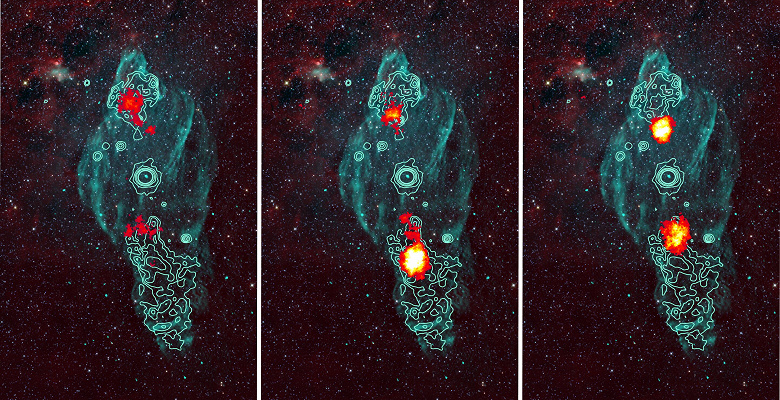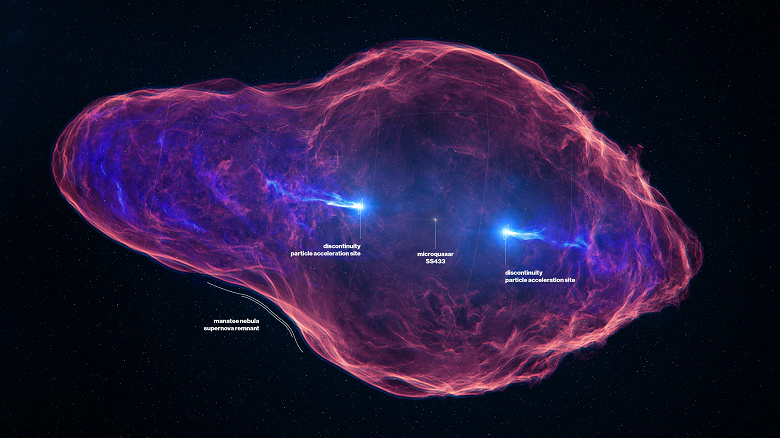Unraveling the shape and energy of gamma radiation from astrophysical jets
An astronomical object called SS 433, discovered in the late 1970s, continues to attract interest from researchers years later. This object emits X-rays at the center of a gas nebula.
SS 433 is a binary star system consisting of a black hole with about ten times the mass of the Sun and a star with a similar mass but occupying a much larger volume. These objects orbit each other with an average period of 13 days.
The gravitational field of a black hole attracts material from the surface of the star, which forms a hot disk of gas that feeds the black hole. When matter falls into a black hole, two narrow jet beams of charged particles (plasma) fall perpendicular to the plane of the disk at a speed approaching a quarter of the speed of light.
The jets of SS 433 are observed in the radio to X-ray ranges at a distance of less than one light year from the central binary star. However, at a distance of about 75 light years from the source, the jets suddenly become bright sources of X-ray radiation. Why this outbreak occurs has long remained a mystery.
Similar relativistic jets are also observed from the centers of active galaxies (for example, quasars), although these jets are significantly larger in size than the jets of SS 433. By this analogy, objects like SS 433 are classified as microquasars. Until recently, observing gamma rays from microquasars was impossible. However, in 2018, a complex of Cherenkov telescopes designed to detect cosmic gamma rays H.E.S.S. The Observatory has detected high-energy gamma rays from the jets of SS 433. This detection indicates that particles within the jets are being accelerated to extreme energies.
However, until now it was not clear how and where exactly particle acceleration occurs. Studying the gamma rays emitted by SS 433 has an important advantage: although SS 433's jets are 50 times smaller than those of the nearest active galaxy (Centaurus A), SS 433 is located within the Milky Way a thousand times closer to Earth. As a consequence, the apparent size of SS 433's jets is much larger, and therefore their properties are easier to study with current generation gamma-ray telescopes.
Researchers from the H.E.S.S. Observatory conducted an observation campaign of the SS 433 system. Thanks to the excellent angular resolution and high precision of the telescopes, they were able to precisely locate the source of the gamma rays within the jets. This turned out to be a very interesting discovery.
The most significant result of the study was the discovery of a shift in the position of gamma radiation depending on its energy. The highest energy gamma ray particles were detected only at the point where the jets reappeared. At the same time, particles with lower energies were detected in more distant regions of the jets.
This observation suggests that gamma radiation in jet streams depends on energy. The researchers were surprised by this result, since they did not expect that particle acceleration occurs precisely at the point where the jets reappear.
«This is the first observation of such a dependence of the form of gamma radiation on energy. The concentration of the highest energy photons at the point where the jets reappear means that particle acceleration occurs there, which was an unexpected discovery», — explained Laura Olivera-Nieto from the Institute at the Max Planck Institute for Nuclear Physics, who led the study of SS 433.
This research has made significant progress in understanding the processes occurring in relativistic jets. By modeling the observed dependence of gamma radiation on energy, the speed of such jets was estimated.
It turned out that the difference between the speed at which the jets are emitted and the speed at which they move indicates the existence of a strong impact — a sharp transition in the properties of the medium, which accelerates the particles further. The shock wave may also explain the appearance of X-ray jets, since accelerated electrons produce X-rays. The inverse Compton effect explains how fast particles transfer their energy to light particles — this occurs when observing high-energy gamma photons.
Brian Reville, of the astrophysical plasma theory group at the Max Planck Institute for Nuclear Physics, explains: “There has been a lot of speculation about the origin of particle acceleration in this system. And they are no longer there: the result really determines the location of the acceleration, the nature of the accelerated particles and allows us to study the movement of large-scale jets emitted by the black hole. Jim Hinton, director of the Institute for Nuclear Physics at the Max Planck Institute for Nuclear Physics, explained that the results completely dispelled previous speculation and brought clarity to the complex mechanisms of particle acceleration.

However, the process of shock wave formation itself remains a mystery. No existing model is yet able to uniformly explain all the properties of jets. Olivera-Nieto plans to further study this issue, which is important because the relative proximity of the system under study provides a unique opportunity to study the acceleration of particles in jets. The results of such research can in the future be used in observations of quasar jets, opening new horizons in the study of the most energetic cosmic rays.
Observing high-energy gamma rays requires the use of a special technique. When a gamma quantum enters the Earth's atmosphere, a collision occurs with atoms and molecules, as a result of which new particles are formed. It is these particles that, like an avalanche, rush towards the Earth and emit Cherenkov radiation, which can be observed using specially equipped large ground-based telescopes.
Gamma-ray astronomy uses the atmosphere as a giant fluorescent screen. The H.E.S.S. Observatory, located in the Homas Highlands of Namibia at an altitude of 1835 meters, plays a major role in the study of high-energy gamma rays. Equipped with an array of five telescopes, which include four 12-meter diameter mirrors and one 28-meter diameter mirror, it is the largest and most sensitive Cherenkov telescope system. H.E.S.S. allows the detection of gamma radiation in the range from several to several tens of teraelectronvolts, which allows the study of the highest energies in the world.

